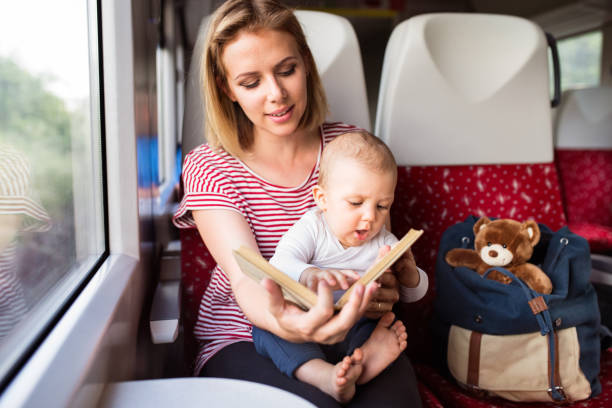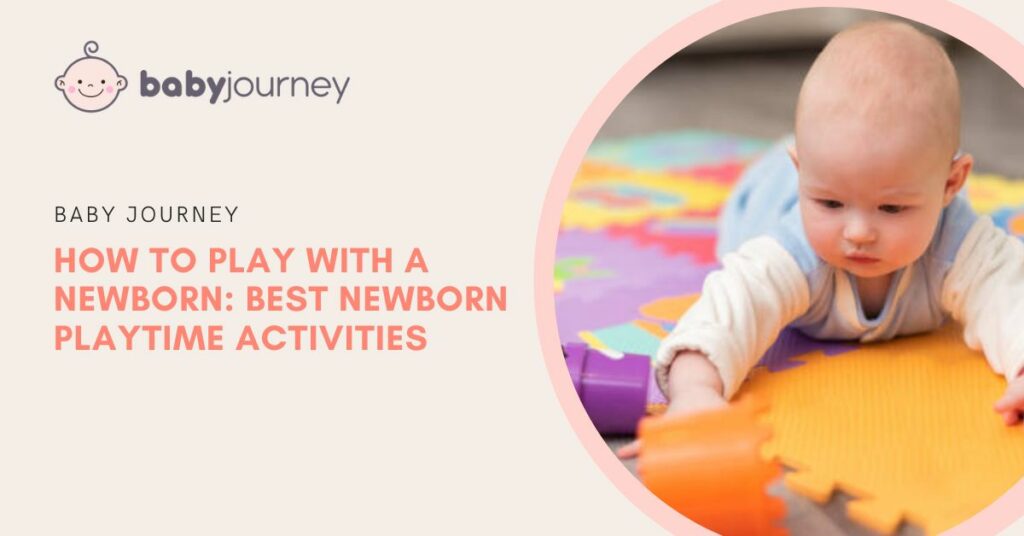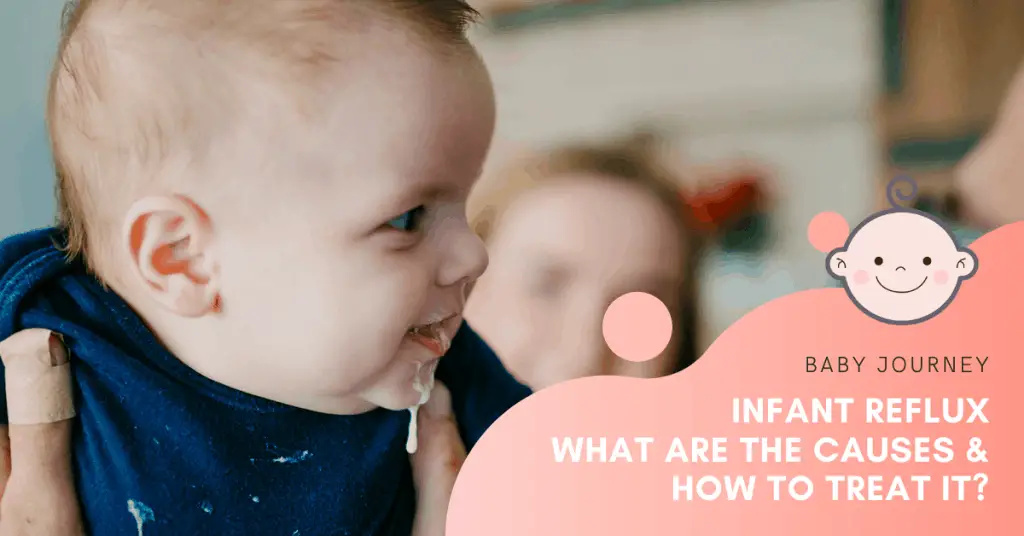You came home with your baby from the hospital. Now what?
You know how to keep the baby fed, clean, and sleeping, but do you know how to play with a newborn?
Luck for you, there are numerous playtime activities and things to do with a newborn, even from the earliest age.
Playtime is essential for newborn babies because they learn about the world around them through play. They also bond with parents and caregivers through play and exploring the environment.
I’ll cover some great newborn play ideas you can try, and explain more about the importance of playing with newborns!
Why Include Playtime in Your Newborn Routine?
Playing with your baby from an early age is essential for overall baby’s development. The best activities for infant development include interaction with people! In addition, different activities also help babies develop gross and fine motor skills.
When you talk to your baby, it gets familiar with words, and syllables, which are essential for future language development.
Furthermore, if you cannot find dedicated time for play every day, just talking to your baby while you do house chores, for example, folding clothes or cooking, can be enough. Babies recognize the sound of your voice from the womb, and hearing it every day in the first few weeks eases the transition to the outside world.
Playtime is great for bonding with your child, and ensuring your baby grows with the feeling of love and safety. Newborn activities allow you to get to know your child and to learn the baby’s cues for what it likes or hates. Soon, you’ll get familiar with the baby’s interests.
Play affects a baby’s sensory perception, promotes social and emotional skills, and makes your baby strong. Therefore, playing ensures the baby reaches developmental milestones such as smiling, saying its first words, crawling, and taking the first steps.
You may be interested in: Baby Walking Before Crawling
When is a Baby Ready to Play and Learn?
Babies learn at their own pace. Parents are there to support their development and ensure their needs are met.
From day one, the baby slowly associates its parents with comfort and nourishments. During those first days, babies spend most of their time sleeping, but you can still interact with them during fun tummy time sessions and baby massages.
Also, when you hold the baby on the changing table, it is an excellent opportunity to let your baby look at your face. Don’t forget about physical contact too! It induces the sense of comfort and affection in babies.

After the first few weeks, babies spend more time awake and ready to play. You can recognize the baby is ready to play after diaper changes and meals when the baby feels happy.
The baby will look alert and is more responsive to sounds. The little one might even look around to understand the source of the sound. Fussy babies aren’t ready for play. Calm the baby first, and ensure their needs are met. Then, encourage playtime and learning.
Also, avoid playing with an active baby. Your baby will kick legs, squirm, or flap arms. During those moments, the baby will struggle to focus on you, so wait until the baby gets less stimulated.
Newborn Play Ideas
Let’s talk about fun activities to do with newborn so you can get the most benefit of playtime with your baby!
You’ll also learn how to entertain a newborn without toys, using only the sound of your voice and physical contact.
As the baby grows, you can include newborn baby toys to stimulate the baby’s vision and introduce the baby to different textures.
Keeping Eye Contact
For younger babies, keeping eye contact for a couple of minutes is more than enough for playing.
Looking into a baby’s eyes for several minutes positively affects the baby’s communication skills. It also releases oxytocin in the parents’ and babies’ brains, which increases the bond between you and your baby.
Tummy Time
You can practice tummy time as soon as the umbilical cord falls off.
Further reading: When to Start Tummy Time
You can put the baby on a play mat or place it on your chest. Baby’s neck muscles will get stronger, and you get a chance for a closer interaction with your baby. If the baby gets bored, you can use toys, cards, sing, or make silly faces to keep the baby entertained.

Singing
Mom’s voice is the most important sound for your baby, and your little one enjoys listening to it!
So, try to sing to your baby as much as possible. You can sing children’s songs or your favorite music, it doesn’t matter. Songs for kids, the ones with repetitive syllables, are great for language skills!
Reading
Reading is an excellent activity for children of all ages. Reading to a baby promotes curiosity and your baby’s imagination. It helps the baby to practice focus and helps with other social skills.
Another benefit of reading books is that babies can start copying sounds, learn new words, ask questions, and recognize pictures!

Baby Talk
Interaction with your baby is the best way to teach your baby about the surrounding world. Babies communicate with parents through crying, body movements, and facial expressions. When you talk to the baby, give them time to answer in their own way!
Giving Textured Toys
Teaching baby about textures helps them to understand the world and helps with motor skills. New textures increase the baby’s ability to engage with objects and communicate.
You can get specialized toys with different textures or offer standard household objects such as towels, blankets, or plastic items.
Using High-Contrast Cards
Babies have a blurred vision in the first several weeks after birth. Vision will gradually get sharper with time, and babies will then start recognizing colors and objects.
Therefore, showing black and white images is an excellent idea to keep the newborn entertained and improve their vision.

Making Silly Faces
Babies imitate parents’ faces, so when you smile, the baby smiles too! Imitation is an important step in a baby’s emotional development and face recognition.
Stick your tongue out, or open your mouth wide and watch your baby copy you. It is a wonderful way of playing and teaching babies about similarities between the baby and other people.
Count Baby’s Toes
Did you know babies are fascinated by fingers and toes? Counting toes is a simple, yet fun activity to try with your newborn.
It raises body awareness in babies and is great for simple entertainment. When you notice your baby focusing on hands or feet, try counting toes and singing a suitable rhyme!
Mirror Play
You can introduce mirror play during tummy time for babies around four months. At that point, the baby should be able to track objects with their eyes, respond to emotions and recognize faces. Use a baby-safe mirror to build empathy, self-awareness, and emotional skills.
You may be intrested in: Tummy Time Alternatives
Peek a Boo
Peek-a-boo is another excellent newborn activity you can try anytime, anywhere. Older babies respond better to the game. When you cover your face and show up again with an accompanying sound, the baby will be surprised and delighted!
Play peek a boo and expect a lot of giggles during playtime! From a learning perspective, peek-a-boo helps with visual tracking, affects the baby’s sense of humor, and stimulates senses and social skills.
Using Dangling Toys
Do you think about when do babies start playing with toys? It happens after six months, but you can introduce a dangling toy sooner. Put the toy into the baby’s hands and let them hold it for several seconds.
It will help with fine motor skills. Also, you can use dangling toys to catch the baby’s attention during tummy time to increase visual awareness skills. Make sure the toys are bright and don’t contain small detachable parts.
Final Thoughts
There is so much you can do with an infant other than bathing, changing diapers, and gentle sway!
Include storytime and play experiences into an everyday newborn routine to keep the baby learning and happy! You can start from day one with simple eye contact with tummy time and get more creative as the baby grows.
Not only will you stimulate the baby’s senses and progress, but you will also build a stronger connection with your precious little one.
I hope you find this article helpful!! Leave a comment if you have any questions. Also, which activity is your favorite? I prefer singing with my baby, especially now when she is such a songful toddler!
–




